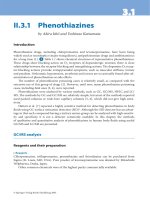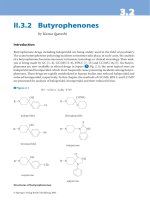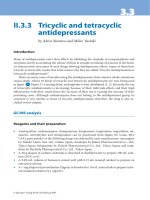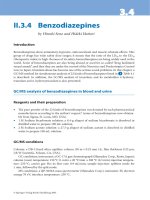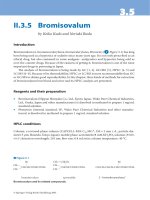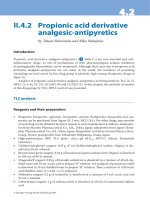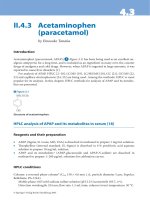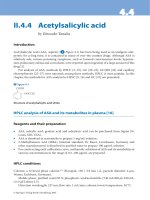Tài liệu Drugs and Poisons in Humans - A Handbook of Practical Analysis (Part 43) pptx
Bạn đang xem bản rút gọn của tài liệu. Xem và tải ngay bản đầy đủ của tài liệu tại đây (100.72 KB, 3 trang )
5.15.1
© Springer-Verlag Berlin Heidelberg 2005
II.5.1 Hypochlorite
By Yasuo Seto
Introduction
Hypochlorite
a
( HClO) is a weak acid, which exerts oxidative action; it is being widely used in
the salt forms for bleaching and other purposes. Sodium hypochlorite ( NaClO) aqueous solu-
tion is usually used as a disinfectant, bleaching agent, fungicide and ink eraser, and is thus
usually included in detergents for laundry. Calcium hypochlorite [ Ca(ClO)
2
, bleaching pow-
der] is also used as a bleaching agent and disinfectant. e kinds of household utensils contain-
ing hypochlorite are numerous; therefore the poisoning cases, due to accidental ingestion of
hypochlorite and due to inhalation of chlorine gas produced upon mixing a hypochlorite salt
with an acidic solution, are relatively many. e toxicity of the aqueous solution of a hypochlo-
rite salt is due to injuries of the mucous membranes caused by its strong alkali and oxidizing
actions, and due to disturbances of the respiratory organs caused by inhalation of chlorine gas
produced under acidic conditions. e oral LD
50
value of hypochlorite for rats is 850 mg/kg.
To detect hypochlorite, a preliminary qualitative test using the iodine-starch paper is being
usually used. However, this method is not speci c for hypochlorite, but is generally responsive
to every oxidizing compound; it is not suitable for specifying hypochlorite. For analysis of
hypochlorite, the detection of a hypochlorite ion is most preferable. In this chapter, a capillary
electrophoresis (CE) method for analysis of hypochlorite is presented.
Reagents and their preparation
Sodium hypochlorite solution commercially available is diluted with 0.05 M NaOH solution to
prepare 500 µg/mL (in the form of a hypochlorite ion) stock solution. Various concentrations
of the solution are prepared by diluting the stock solution with 0.05 M NaOH solution for
constructing a calibration curve.
CE conditions
CE column: a fused silica capillary column (104 cm × 50 µm i. d.)
CE conditions: an HP
3D
CE system (Yokogawa Analytical Systems, Tokyo, Japan); bu er
solution: HP Basic Anion Bu er; column temperature: 30 °C; impressed voltage: –30 kV;
detection: indirect absorption detection (signal 350/20 nm, reference 275/10 nm); sample in-
jection: pressure injection (50 mbar, 6 s).
404 Hypochlorite
Procedure
i. A specimen solution is appropriately diluted with distilled water, and passed through a
membrane lter of 0.25 µm cellulose acetate.
ii. e above solution is placed in a sample vial to be set for CE.
iii. Calculation: known concentrations of hypochlorite solutions are analyzed by the above CE
to construct a calibration curve (concentration of a hypochlorite ion in a specimen vs. peak
area). A peak area obtained from a specimen is applied to the calibration curve to obtain its
concentration.
Assessment of the method
> Figure 1.1 shows an electropherogram for the standard solution of 500 µg/mL hypochlorite
ion. e hypochlorite ion ( ClO
–
) was eluted at 8.2 min. Peaks observable at 6.0, 6.9 and 7.1 min
were due to chloride ion ( Cl
–
), chlorate ion ( ClO
3
–
) and carbonate ion ( CO
3
2–
), respectively.
Even in the undiluted sodium hypochlorite solution, decomposition product chloride and
chlorate ions are contained. During preparation of the solutions and also during analysis, there
is a possibility of decomposition of the hypochlorite ion. As shown in
> Figure 1.1, the peaks
of such decomposition products are remarkably observed even in the electropherogram for the
standard sodium hypochlorite solution. e carbonate ion observed in the chromatogram is
due to atmospheric carbon dioxide, which is easily dissolved in alkaline solution.
e present CE conditions can be used for general analysis of negative ions, including
cyanide, azide and arsenate [1, 2]; the conditions can be also applied to chlorate and analogous
anions. e pH of the bu er is about 12; under this condition, the decomposition of hypochlo-
rite ion is suppressed. Since it is di cult to prepare the standard hypochlorite solution without
any decomposition, the true hypochlorite concentration in a specimen is lower than the value
calculated using the calibration curve.
⊡ Figure 1.1
Electropherogram for the hypochlorite ion (data donated by Yokogawa Analytical Systems).
405
Toxic and fatal concentrations
e hypochlorite is decomposed very easily. Especially in biomedical specimens, it reacts with
proteins and other components and is decomposed very rapidly. Because of such reasons, there
are no data available on the fatal blood levels of hypochlorite. ere is a report describing the
di culty for detecting hypochlorite from blood of a victim, who committed suicide by ingest-
ing a bleaching agent [3].
Notes
a) Hypochlorite is very unstable in acidic aqueous solution. It is decomposed to produce
chlorine gas. At neutral pHs, the compound produces both chlorate and chloride ions by
disproportionation reaction; at alkaline pHs, it is relatively stable. Hypochlorite is decom-
posed under weakly alkaline or weakly acidic conditions to produce chloride ion together
with oxygen in the activated state, resulting in its bleaching action.
References
1) Yokogawa Analytical Systems (1999) Instruction Manual for the Kit To Be Used for Capillary Electrophoresis
Analysis of Toxic Anions, HP5964-3029, Tokyo (in Japanese)
2) Soga T, Ross GA (1999) Simultaneous determination of inorganic anions, organic acids, amino acids and carbo-
hydrates by capillary electrophoresis. J Chromatogr A 837:231–239
3) Kamiyama S, Beppu K (1979) A fatal suicidal case by drinking of liquid bleach. Jpn J Legal Med 33:13–19 (in
Japanese with an English abstract)
Hypochlorite
